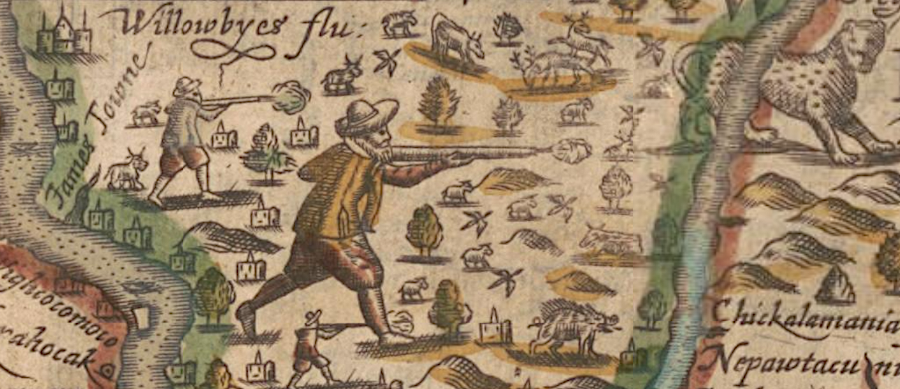
the first colonists may have seen wild cats (mountain lions) near Jamestown
Source: Library of Congress, Virginia (by Ralph Hall, 1636)

the first colonists may have seen wild cats (mountain lions) near Jamestown
Source: Library of Congress, Virginia (by Ralph Hall, 1636)
When Europeans reached the Chesapeake Bay in the 1500's, they encountered Native Americans who had domesticated one animal. Dogs had migrated with the Paleo-Indians into North America. The ancestors of the indigenous dogs were wolves that had been domesticated in Asia (and perhaps the Middle East, in two separate places initially) about 15,000 years ago.
The first immigrants who kayaked along the Pacific Ocean coastline to bypass the ice sheet at least 23,000 years ago may have traveled without dogs. The oldest evidence of domesticated dogs has been found in British Columbia; it dates back to 13,100 years ago.
Many of modern breeds were developed in the Victorian era, but by 8,000 years ago about half of the canine diversity had evolved. It is likely that first people to reach the Atlantic Ocean, perhaps 20,000 years ago when sea level was 400' lower and before the Chesapeake Bay had formed, arrived without dogs.
The first migrants moving south to California in their kayaks may not have brought those animals. Later arrivals from Beringea, moving on land along the shoreline and through a gap between melting ice sheets on a southward migration into modern-day Montana, brought domesticated dogs that became companions and hunting assistants.
Indigenous dogs would have served as camp guards and provided warnings for defense of Woodland Culture towns. While dogs were also a source of food in some pre-Contact societies in North America, the first English who settled Jamestown reported that the Native Americans in eastern Virginia did not eat their dogs.
Some dogs were buried, perhaps after ritual killing, but the animals were used primarily as aids for hunting and not as pets. Archeologists have excavated remains of 117 dogs at Weyanoke Old Town near modern Hopewell. The site is the largest collection of indigenous dogs found to date in North America. Analysis of DNA from an indigenous dog skeleton at Jamestown reveals it was related to the population upstream near the Appomattox River.
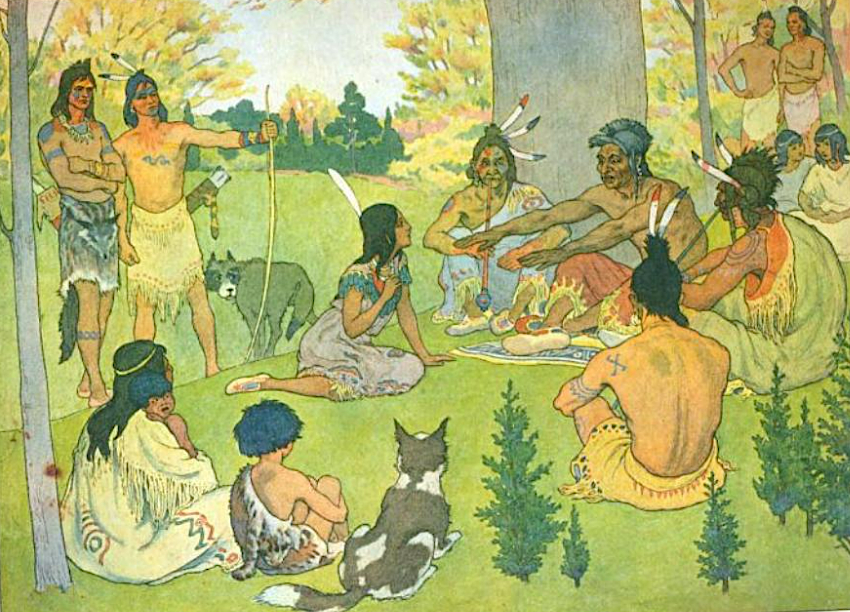
many images of Pocahontas are fanciful - but it is realistic to picture dogs with Native Americans when Jamestown was founded in 1607
Source: Elmer Boyd Smith, The Story of Pocahontas and Captain John Smith (1906)
Almost all modern dogs are genetically descended from the animals brought by colonists; the indigenous dogs disappeared from the landscape. To the English, the Native American dogs resembled foxes. In 1612 William Strachey documented one distinctive characteristic - the dogs were "barkless":1
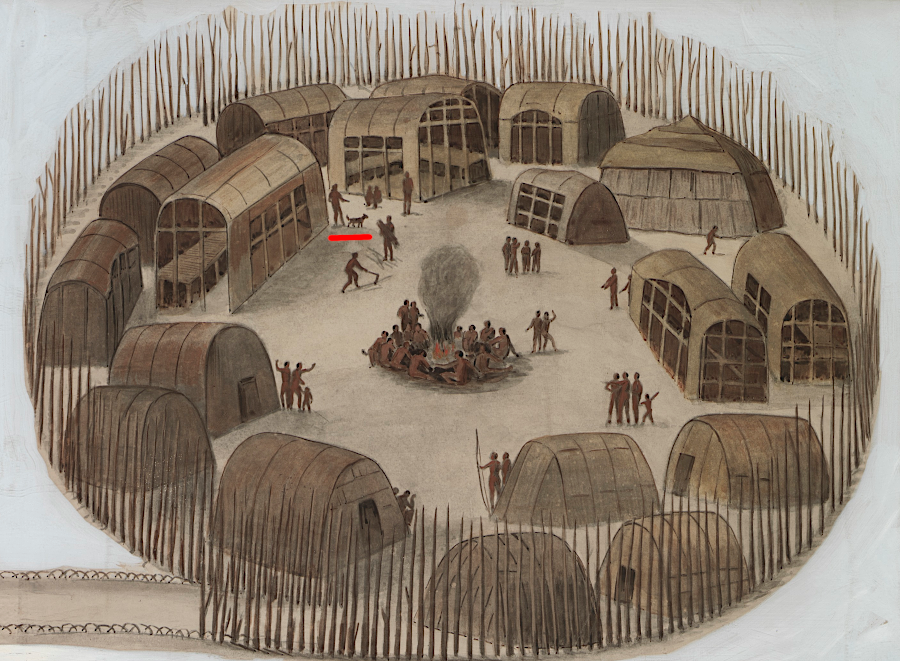
in 1585, John White documented dogs in the town of Pomeiock
Source: Smithsonian Institution, The Town of Pomeiock (oil painting by Spencer Nichols)
The indigenous dogs were about the size of a modern beagle or springer spaniel, weighing around 35 pounds. The English brought dogs about the size of shepherds, weighing 50-70 pounds. They gave Powhatan a white greyhound.
To the English, dogs were a potential food source in times of great hunger. When the early colonists at Roanoke Island explored too far upriver in 1585 and ran out of food, they ate two mastiffs which had been brought across the Atlantic Ocean. Similarly, when the Jamestown experienced the "Starving Time" in the winter of 1609-10, they used indigenous as well as their imported dogs as a food source. In contrast, the Native Americans in Virginia are thought to have used their dogs as sentinels and hunting assistants but not as food.
The Jamestown settlers viewed the indigenous dogs as mongrels. There were no separate breeds until the colonists arrived. John Smith and Christopher Newport sought to impress Powhatan in 1608 by giving him a white greyhound. That distinctively different dog would have been an obvious prestige item that helped the paramount chief to impress others.
After Pocahontas was kidnapped in 1613, Powhatan asked for restitution that included another English dog. By 1619, however, trading dogs with the Native Americans that might improve the quality of their stock was no longer acceptable. The first General Assembly in 1619 passed legislation saying:2
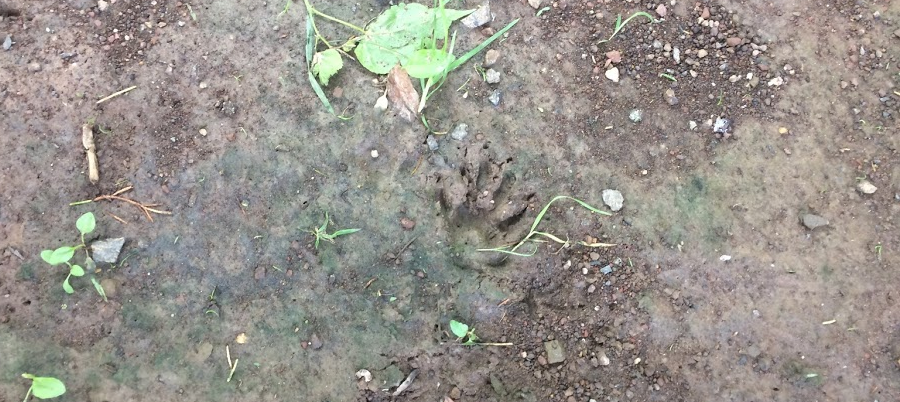
raccoons were common before Europeans arrived in the 1500's - and are still common today
Dog trading was re-established by 1698 when the Fredericksburg Dog Mart started. The Manahoac, Pamunkey, and Mattaponi would travel to Fredericksburg to acquire English hunting dogs, exchanging furs and food to obtain better genes. The trading continued, one day a year, until the beginning of the American Revolution.
The Fredericksburg Dog Mart was restarted in 1928 by the Fredericksburg Chamber of Commerce. Today the "oldest dog event in America" is an annual event at the start of the hunting season, hosted by the Fredericksburg-Rappahannock Chapter of the Izaak Walton League of America.
The breed of Native American dogs dating back thousands of years is now recognized as the "Carolina Dog." They are considered the smartest breed in North America, skilled in silent (barkless) tracking of deer and intelligent enough to escape a standard kennel.3
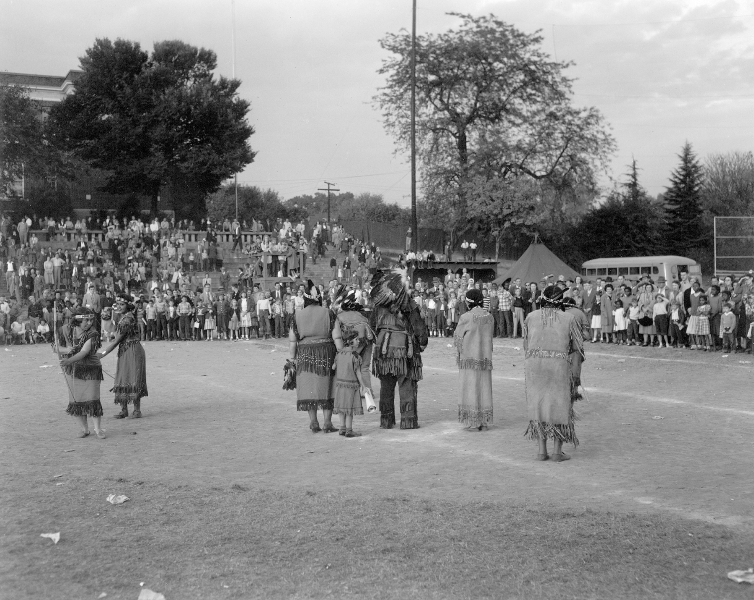
the Pamunkey were highlighted after the Fredericksburg Dog Mart restarted in 1928
Source: Library of Virginia, Every Dog Will Have His Day
In contrast, domesticated cats (Felis catus) did not reach the Western Hemisphere until the Spanish arrived. Columbus may have had cats on his ships in 1492, since the Spanish kept them to reduce mice that ate the mariner's food. The first archeological evidence of domesticated cats in North America comes from two skeletons excavated from a Spanish galleon that sank off the Florida coast in 1559 CE. Based on the assessment of the skeletons, the cats were well-fed "mousers."
There were cats at Jamestown, probably arriving with the first three ships. They were all gone by 1610. As recorded later by George Percy, the cats were consumed as food during the Starving Time during the winter of 1609-10:4
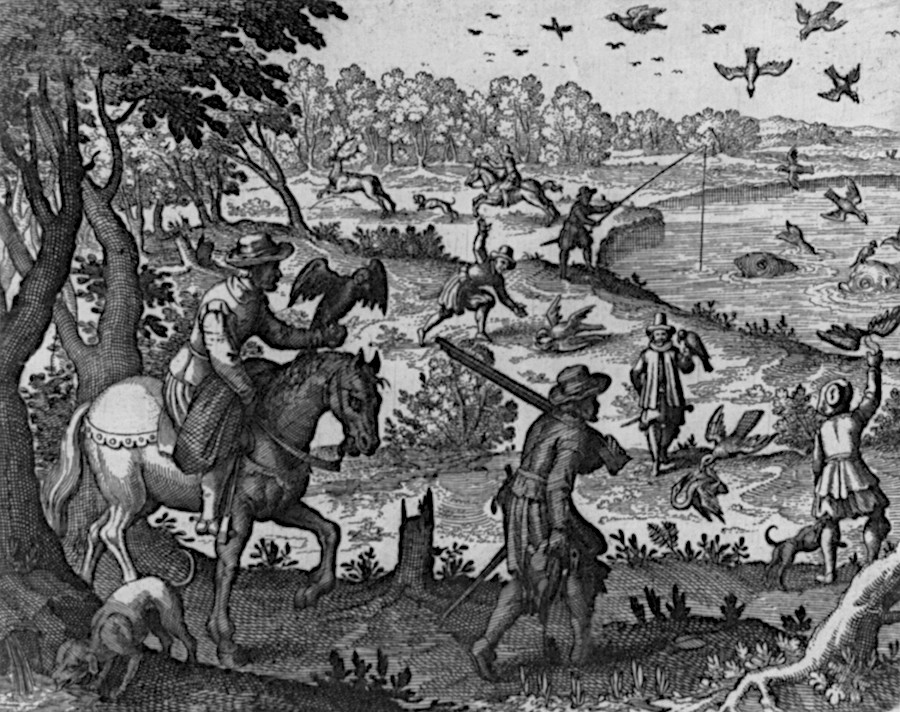
early English colonists were delighted at the large numbers of wildlife in Virginia
Source: Library of Congress, The great abundance of fish and game in Virginia; man hunting with muskets and falcons, and fishing (by Theodor de Bry, 1618)
John Smith wrote fascinating reports of the plant and animal life he found in the New World in the early 1600's, and the "time of discovery" extended into the 1700's as Europeans gradually reached the Appalachian plateau in far southwestern Virginia. Speculation was slowly replaced by observation.
John Lederer described seeing a mountain lion killing a deer, in his journal of a 1669 trip up the Pamunkey River to the Blue Ridge:5
State biologists have not documented any mountain lions that may still remain in Virginia, despite regular reports of sightings. The only wildcats today are the much smaller bobcat and the large number of feral pets abandoned by their owners.
Deer are more common today than when the Europeans first reached Virginia, because the habitats have been so heavily altered by farming and then housing development.
One species that was most obvious to the early discoverers was the passenger pigeon. These are now extinct, eliminated not only from Virginia but from the face of the earth. The last one to die, named Martha, has been stuffed and can be seen in a zoo.
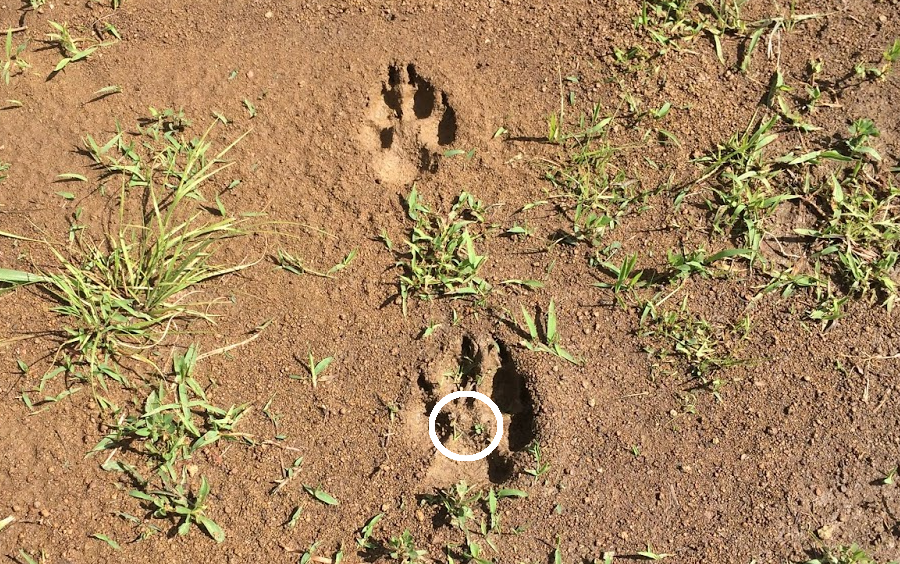
modern coyote footprint on Manassas Battlefield National Park (raised pad in middle is uncommon for domestic dogs that walk on hard surfaces)
Source: Eric Toensmeier, indigenous management
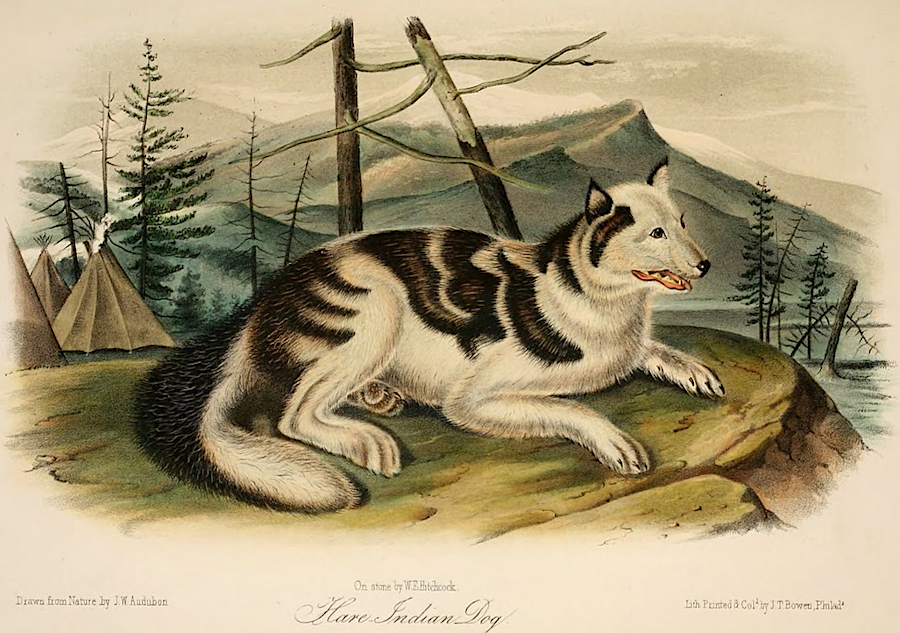
John James Audubon painted an indigenous dog found on Great Plains, living near teepees rather than the yi-hakins in Virginia
Source: Wikipedia, Hare Indian Dog
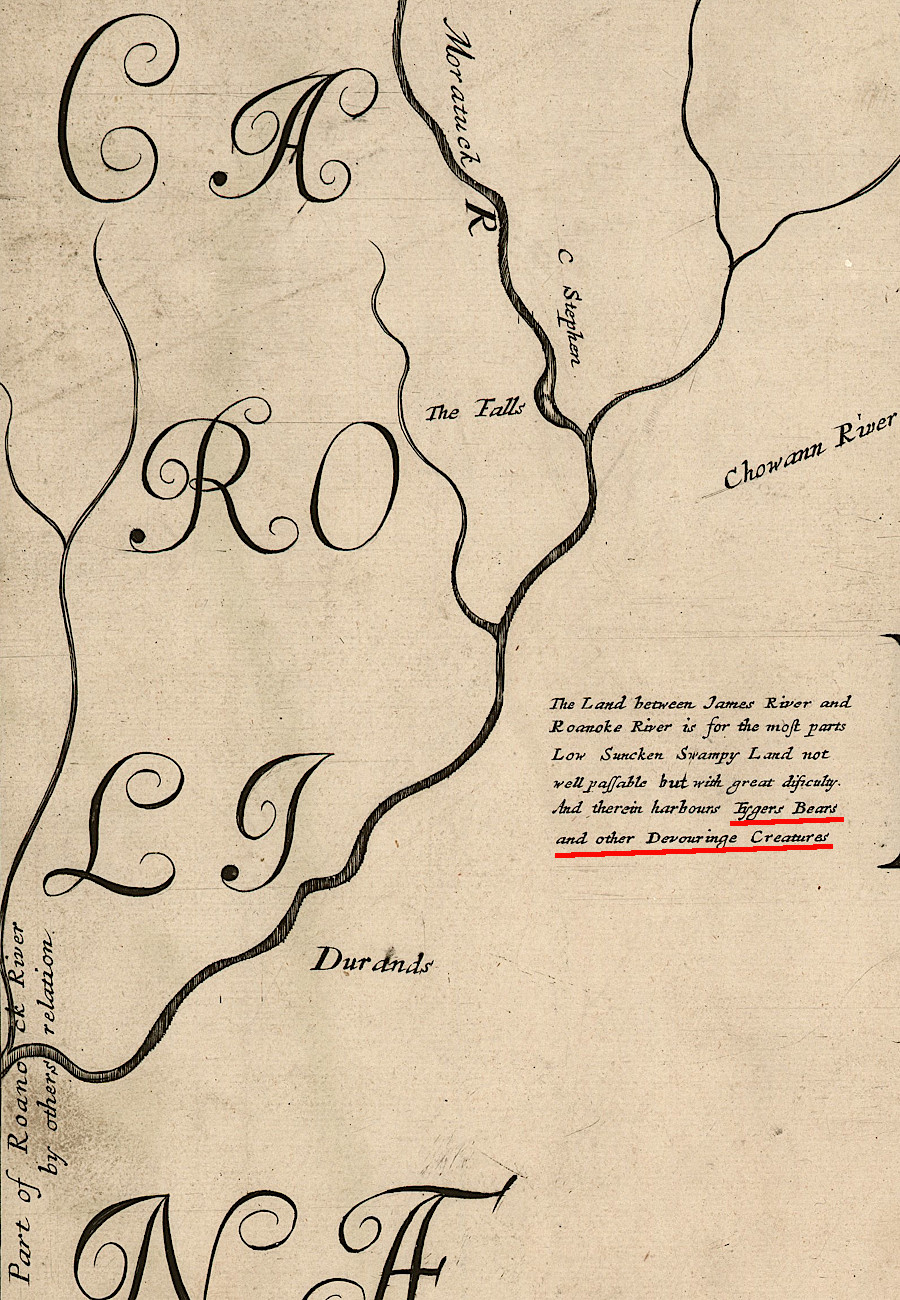
in 1670, Augustine Herrman speculated that there were "Tygers, Bears and other Devouringe Creatures" south of the James River
Source: John Carter Brown Library, Virginia and Maryland As it is planted and Inhabited this present Year 1670 (by Augustine Herrman, 1670)